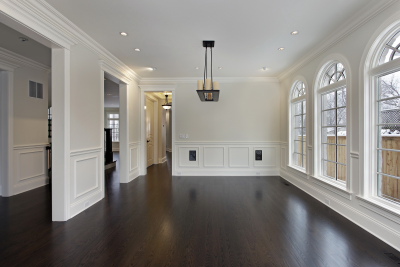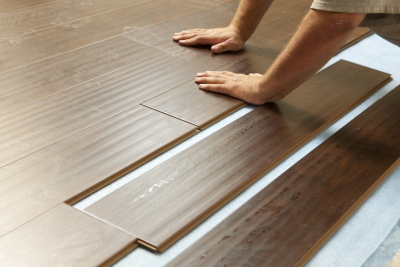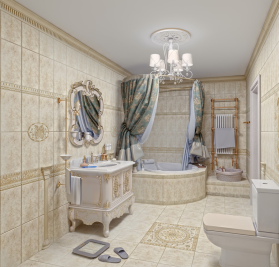Wood flooring maintains its value over time. Installing wood flooring is a valuable investment for your home. Other flooring options may require more frequent maintenance and get easily worn out, wood floors can be easily refinished to the original look in order to sustain and promote a continuous flow of finesse and elegance to the home.
Wood flooring promotes elegance and warmth in any home. Wood flooring is very durable and can last for many years if properly maintained. In fact, real estate agents tend to encourage homeowners to buy or sell houses that are finished with wood flooring because of the greater value it has to offer.
Maintenance for wood flooring is easy. Ensure that the appropriate cleaning product is chosen for the type of flooring. You may want to check with our team or the floor manufacturer for further details.
Wood floor is a natural resource which makes it ecologically friendly. This type of flooring is both renewable and recyclable. Wood is an excellent choice since it does not trap dust and other allergens. Health organizations would approve using wood flooring as a preferred option for a healthy home.

Today there are more varieties of wood to choose, whether it is the style, color, durability or species of flooring. Species of flooring may be sleek bamboo, traditional oak, elegant cumaru, country pine and many more. Recently Bamboo has been promoted because its production has the least effect on the environment and its durability is on par with many other commonly used wood options.
Hardwood
Hardwood flooring is 100% authentic wood. This type of flooring is long lasting and strong but the price to install hardwood can be costly. The varying cost usually depends on the species of wood chosen. Although hardwood brings more value to your home, it does also have its disadvantages. Hardwood can be affected by prolonged moisture exposure and can be scratched easily.
The life expectancy for hardwood can be over 75 years. Over time it is recommended to refinish the flooring to its original look, especially in high traffic areas where there is usually more wear and tear. Refinishing may require sanding, staining and a few layers of clear coat, urethane finish.
Hardwood needs to be placed in the home about a week prior to installing for it to acclimatize to its surroundings. This ensures that the wood expands and contracts to the humidity of the environment.
Hardwood flooring is rated by its hardness and colour finish. Here are some of the common species that would be encountered when trying to buy hardwood. The Janka Hardness in this chart is stated as pounds force. If you see other charts they may be stated in Kilograms or Newtons. If the wood you are buying is not listed below, Wikipedia has a more complete chart.


Laminate
Laminate flooring is made from wood fibers that is heated and compressed together at high temperatures. Similar to hardwood flooring, laminate is also durable. Choosing laminate over hardwood flooring can save you some money. Unlike hardwood flooring, laminate can resist some scratches. Quite often one cannot see the difference between hardwood and laminate.
Laminate cannot be restored as easily as hardwood flooring.
If damaged, it needs to be replaced. Laminate is installed as a floating floor, without the use of fasteners, such as nails or screws. On wood floors, it can be installed using a foam underlayment. For basements, it should be installed on a moisture control underlayment that allows the concrete to breathe, and ensures that the floor is dry and warm. This would also help to reduce or eliminate mold buildup under your floors. Laminate floors are much easier to install than hardwood or tiles.
Laminate floors are available in several styles and colours. Some even imitate tile and hardwood and it may be difficult to tell the difference. Laminate floors are generally sold in thicknesses of 7mm, 8mm, 10mm and 12mm. Any thickness would provide the same look, shine, resistance to scratch and resistance to dents. The thicker floors are more resilient to breakage during installation, would react better to bending for uneven floors and would provide better insulation for a warmer floor.
Underlayment for laminate comes in different thicknesses and quality. As previously mentioned, for the basement the underlayment has a bubble texture to allow air under the padding. This helps moisture to dry out faster, helps the concrete to breathe, reduces mold buildup and provides better insulation for a warmer floor. For the upper floors a better underlayment would help with uneven floors, help with insulation and most importantly provide an acoustic sound barrier. These can be determined by the ratings on the underlayment, such as Impact Insulation Class (IIC) and Sound Transmission Class (STC) ratings.
Laminate is made of four layers. The top layer is filled with Aluminum Oxide to protect it from constant wear and scratches. This also makes it stain resistant, fade resistant and easy to clean. The second layer is the decorative part that provides its visual beauty. This can be made to mimic the grains of most species of wood and tile, so that it looks just like ordinary hardwood or tile. The third layer or core layer provides the structure and dent resistance capabilities. This enables laminate to be much more dent resistant than normal hardwood. The final layer provides support and stability so that it does not break when placed on various subfloor types.
As you can see a lot of engineering has been invested in making laminate flooring. As such, laminate floors have a lot of advantages over regular hardwood flooring. They are:
- Easier to install
- Cleans easily
- Stain resistant
- Fade resistant
- Better resistance to dents
- Better resistance to scratches
- When combined with its underlayment provides better insulation and sound barrier

Linoleum/Vinyl
Both linoleum and vinyl are resilient and durable flooring materials. Linoleum is made from more natural products but may not necessarily be more eco-friendly than vinyl. You may want to request the VOC information and compare them before deciding on which is more eco-friendly.
Linoleum may offer a wider range of colours and designs than vinyl to better suit your décor. It is however more difficult to maintain. Vinyl, which is basically petroleum based, may boast a better resistance to staining, scratches and wear. Linoleum may also have a greater tendency to fade or change colour over time.
Both vinyl and linoleum are easier to install than ceramic tiles. In the past, they were the preferred material for kitchen floors because falling items would not do damage. Ceramic tiles may crack or wood floors may dent when a heavy object is dropped.
More recently, vinyl tiles are being grouted to look like ceramic tiles. In a kitchen this can look even more authentic if a ceramic backsplash is used. Some people prefer the vinyl in large rolls as opposed to individual tiles. The rolls would reduce the amount of joints or seams, which is better for wear and cleaning. Alternatively, individual tiles are easier to replace if there is damage. Individual tiles also provide the option to be more creative by mixing designs or laying in different patterns.
Vinyl or linoleum would result in a softer, warmer floor than ceramic tiles. Either floor can be damaged by extreme temperatures, may fade with too much direct sunlight, can be permanently damaged by heavy chemicals, especially acids, bleach and gritty cleaners, and can be left with permanent imprints from heavy furniture or sharp objects.

Ceramic, Porcelain or Stone Tiles
These are some of the preferred choices for entranceways, kitchens and bathrooms. In many cases they are also the preferred choices for basements and commercial flooring. Tiles last very long and are generally considered as a lifetime flooring when a good quality tile is properly installed.
Tiles can be bought in a variety of colours, shapes and textures to form a floor unique to the room. Tiles are also made from natural products, and because they last such a long time and does not need to be thrown out as often, are considered very eco-friendly.
Tiles may cost more per square foot for its initial installation but achieves a better return on investment in the long term, and increases a home’s value. Tiles can be bought for both indoor or outdoor use and are resistant to staining, scratching or fading in either application. Yet our team would not recommend the use of ceramic or porcelain tiles outdoor. Stone tiles are more appropriate for outdoor usage. Tiles can be cleaned by any type of cleaning agent without the risk of damage. Tiles are especially used in areas of high relative humidity because they possess unparalleled ability to withstand moisture and thereby prevent the growth of mold and mildew. In many European countries tiles are actually used throughout the house and the same tile may even extend to the outdoor garden.
Tiles also possess excellent resistance to chemical and biological agents. You would therefore see tiles in a variety of commercial and industrial applications, including, schools, hospitals and shopping malls.
The basic tile is made from clay and water, and hardened by fire. Porcelain tiles generally have better resistance to water. In fact that is the only true difference between porcelain and other clay tiles. Sales people may tell you that porcelain has a deeper glazing and may look better if chipped, unfortunately this is not true. The depth of the glazing depends on the manufacturing process and can be the same for ceramic or porcelain. If you intend to use the same tile outdoors, porcelain may have some advantages because it can better resist water penetration, reducing its chances of cracking due to freezing. Yet, tile packages quite often have information about the tiles ability to withstand freezing, which would be more reliable.
When purchasing tiles, you would want the tile that is best suited for your application. Yet, there is no benefit in buying a tile with more attributes than you need. Salespeople will always try to sell you the upgrades to make more money, it is to your benefit to educate yourself before going to the store.
Our team can help you to obtain the appropriate tiles for your job.

Ceramic, Porcelain or Stone Tiles
Carpeted floors possess unsurpassed comfort. Walking into a carpeted room provides the sense of softness and coziness. Darker carpets create a sense of warmness while lighter colours give you a more airy roomier feeling. Carpet has been used extensively in places with colder climates because it provides an extra layer of insulation, especially if denser fibers are combined with thicker under padding. This method can be really useful on basement flooring. Carpet is also softer for infants and elderly who may fall more often. The carpet padding may help prevent injury. Carpets also provide an extra layer of sound proofing, especially when you have noisy tenants in the basement.
Carpet is not ideal for people with allergies. Even with frequent vacuuming, carpets may still retain a lot of dust. Recently, new parents have been removing carpets from their homes prior to bringing home their new babies to reduce the dust levels and risks of allergies.
Carpet is also susceptible to staining and may cause mold if used in areas of constant moisture. Therefore, do not use it in damp basements or if there is any suspicion of leaks. Carpet tends to retain scent from pets such as cats and dogs and may require more maintenance than other flooring types. Carpets should be professionally steam cleaned on a regular basis to help get rid of deep dirt, stains and scents.
Nylon is the most popular fiber used in carpets because it is easy to clean, highly durable, reasonably stain-resistant and somewhat resistant to fading in the sun. Most carpets are now treated with chemicals to increase their resistance to stains. Some chemicals used in carpets can be carcinogenic such as: formaldehyde, toluene, xylene, benzene and 4-phenylcyclohexene. There are 2 different methods used for obtaining the colours on the carpet; solution dying which makes a uniform colour by dying the fibers prior to making the carpet, and stock dying which is used to only dye the surface after the carpet is made.
Carpets are made in various designs, textures and colours. Therefore, it would be wise to shop around and get a better feel for the different types before buying.
